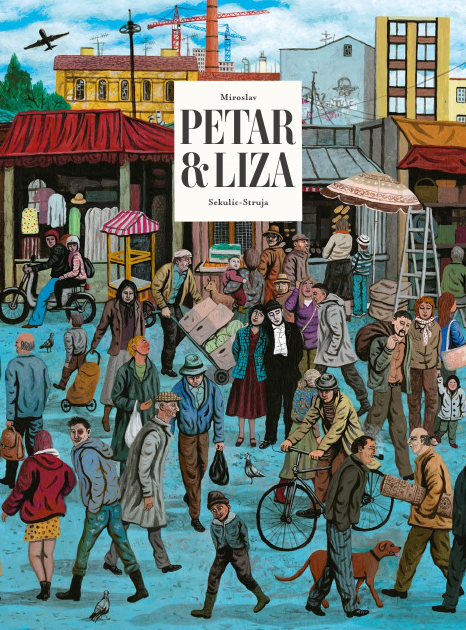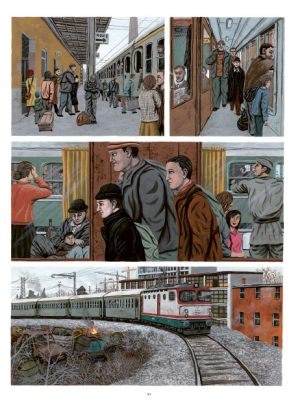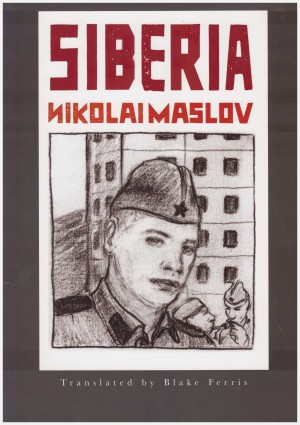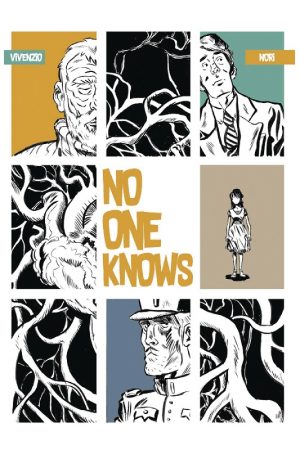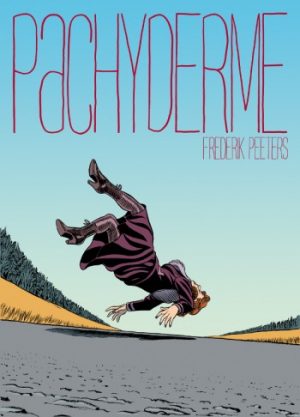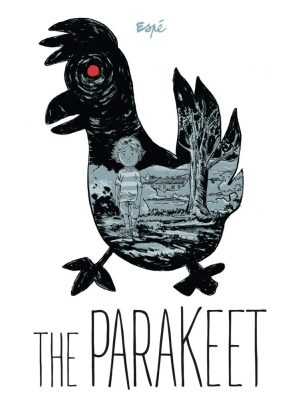Review by Frank Plowright
In a brief introduction to Petar & Lisa Miroslav Sekulic-Struja states he doesn’t intend what follows to be a war story about what was Yugoslavia from the late 1980s onwards, but a transition from one broken system to another. However, with so much of the circumstances informed by a country tearing itself apart, Sekulic-Struja can’t help but produce a very personal story about someone almost at war with himself.
Petar is first seen contemplating his service in what was then the Yugoslavian army. His memories are of comrades and tedious discipline-inducing routine broken by the occasional night of freedom in the town. When that ends and he returns home it’s to an empty existence.
Brightly coloured pages of flat art have more in common with fine art compositions than standard comics, and while the figurework is entirely different, Sekulic-Struja can evoke L. S. Lowry’s busy street scenes as we follow Petar’s journey. There’s also something of the richly characterised and stylised people enjoying life as provided by Beryl Cook. They feature in neatly painted panels where the detail is such that some pages almost become an exercise in spotting the eccentric items pictured, with a long train journey a highlight for doing so. If selecting a single defining artistic characteristic it would be squalor. It’s there in the untidy primitive living quarters over the opening pages, seen in the mess beside the rail tracks on the sample art, and the homes Petar returns to.
In terms of story, tedium is at first the prevailing theme. The train journey occupies several pages with one eccentric inclusion after another providing a real sense of place, but also stressing the time involved. Tedium is also present in the army routine, and Petar’s lack of purpose thereafter. His externally passive personality is contrasted with his internal poetic observations, soaking in the streets and the people he meets, and when not listening in on his inner voice the narrative captions are of others commenting on him. Collectively they build a portrait of a talented and caring man, yet one we’re shown as just one of many gradually losing all hope, his state of mind represented by his shoelaces never being tied.
It’s a fair while before Liza appears, Sekulic-Struja first supplying a false start as Petar wanders aimlessly around the city encountering others with a similar lack of opportunity, some with poetic tendencies. Although Petar and Liza’s paths cross, it’s halfway through before they connect. The art is delightful in depicting the joyful first stages of their relationship with the squalor disappearing as the world is seen in a new light.
Some purpose is lost when Petar and Liza become a couple. Prolonged scenes become indulgent, no longer emphasising time, and the transitions between past and present and dreams and reality are more blurred. War is at times a background, but rarely intrudes on what’s a slice of life narrative where depression eventually becomes an issue. It’s realistically handled showing the terrible toll it takes, yet may not seem that way to anyone who’s not coped with depression.
Petar & Liza meanders, and Sekulic-Struja isn’t capable of making a point concisely, yet the handling of Petar’s journey also has heartbreaking moments and page after page of exquisite art compensates for narrative shortcomings.
